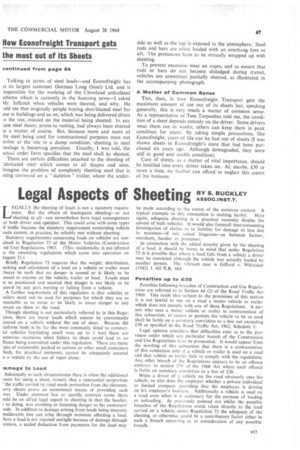Legal Aspects of Sheeting ASSOC.INST.T. BY S. BUCKLEY L EGALLY the
Page 69

If you've noticed an error in this article please click here to report it so we can fix it.
sheeting of loads is not a statutory requirement. But the effects of inadequate sheeting—or not sheeting at all--can nevertheless have legal consequences or both driver and operator. This could arise with some types 4 traffic because the statutory requirement concerning vehicle oads cannot, in practice, be reliably met without sheeting.
Statutory requirements concerning loads on vehicles are conained in Regulation 73 of the Motor Vehicles (Construction nd Use) Regulations, 1963. (This, incidentally, is not affected iy the amending regulations which came into operation on kugust 21.) Briefly Regulation 73 requires that the weight, distribution, lacking and adjustment of a toad on a vehicle or trailer must iways be such that no danger is caused or is likely to be aused to anyone on the vehicle, trailer or load. Loads must le so positioned and secured that danger is not likely to be aused by any part moving or falling from a vehicle.
A further requirement of this regulation is that vehicles or sailers must not be used for purposes for which they are so nsuitable as to cause or be likely to cause danger to any erson on them or the road.
Though sheeting is not particularly referred to in this Regoshun, there are many loads which cannot be conveniently ecured on a vehicle without the use of sheet. Because the latforrn body is by far the most commonly fitted -to commerial vehicles (excluding small vans up to 1 ton) there are umerous occasions when failure to sheet could lead to an hence being committed under this regulation. There are many pes of commodity packed in cartons or other small containers 'hick for practical purposes, cannot be adequately secured n a vehicle by the use of ropes alone.
lamage to Load
Admittedly in such circumstances there is often the additional :ason for using a sheet, namely that a substantial proportion ' the traffic carried by road needs protection from the elements. orry sheets prove an economical means of providing such iver, Under common law or specific contract terms there told be an allied legal aspect to sheeting in that the haulier, so doing, was avoiding or lessening danger to his customers' 'eds. In addition to damage arising from loads being insecure, ■ nsiderable loss can arise through moisture affecting a load. here a load is not rejected outright because of damage through oisture, a scaled deduction from payments for the load may
be made according to the extent of the moisture content. A typical example in this connection is malting barley. Here again, adequate sheeting is a practical necessity despite the advent of bulk vehicles. It would also forestall time-consuming investigation of claims as to liability for damage or loss due to moisture—if not actual litigation—as between farmer, merchant, haulier or processor.
In connection with the added security given by the sheeting of a Toad, it should be borne in mind that under Regulation 73 it is possible that where a load falls from a vehicle a driver may be convicted although the vehicle was actually loaded by another person. The relevant case is Gifford v. Whittaker (1942) 1 All E.R. 604.
Penalties up to £50
Penalties following breaches of Construction and Use Regulations are referred to in Section 64 (2) of the Road Traffic Act 1960. This reads that subject to the provisions of this section it is not lawful to use on a road a motor vehicle or trailer which does not comply with any of these Regulations. •A person who uses a motor vehicle or trailer in contravention of this subsection, or causes or permits the vehicle to be so used shall be liable on a summary conviction to a fine not exceeding 150 as specified in the Road Traffic Act, 1962, Schedule 1.
Legal opinion considers that difficulties exist as to the provision under which any particular breach of the Construction and Use Regulations is to be prosecuted. It would appear from the wording of this subsection that there is a contravention of this subsection only if a vehicle or trailer is used on a road and that vehicle or trailer fails to comply with the regulations. Any other breach of the Regulations appears to be an offence contrary to section 239 of the 1960 Act where each offence is liable on summary conviction to a fine of 120.
While a driver, of a vehicle on the road obviously uses his vehicle, so also does the employer whether a private individual or limited company pi oviding that the employee is driving on h:s employer's business. Additionally a vehicle is used on a road even when it is stationary for the purpose of loading or unloading. As previously pointed out whilst the possible breaches of the Regulations could relate directly to the load carried on a vehicle under Regulation 73 the adequacy of the sheeting, or otherwise, could be a contributory factor either in such a breach occurring or in consideration of any possible breach.




















































































































